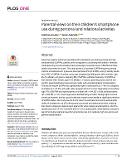Parental views on their children’s smartphone use during personal and relational activities

Publication date
2024Published in
PLoS OneVolume / Issue
19 (8)ISBN / ISSN
ISSN: 1932-6203ISBN / ISSN
eISSN: 1932-6203Metadata
Show full item recordCollections
This publication has a published version with DOI 10.1371/journal.pone.0308258
Abstract
Given the negative outcomes associated with smartphone use during personal and relational activities (SUPRA), parents strive to regulate its use among their children. However, media parenting recommendations lack knowledge of parental views on SUPRA and their relative occurrence in youths. This study aimed to (i) estimate SUPRA frequency among children and adolescents, (ii) assess parental dislike (PD) of SUPRA, and (iii) identify predictors of PD of SUPRA. An online survey was completed by 826 parents (49% mothers, age 25-74, Median = 43 years), capturing PD of SUPRA, estimated frequency of SUPRA in their children (49% female, age 6-18, Median = 10 years), parenting styles (warmth and control), parental attitudes toward screen media, and sociodemographic characteristics. The rate of frequent SUPRA was significantly higher in adolescents (2.7-48.1%) compared to children (2.1-27.2%) with odds ratios ranging from 0.67 to 3.04, depending on the activity type. PD of SUPRA was high in parents of children (M = 4.04, SD = 0.66) and adolescents (M = 3.93, SD = 0.71). Linear regression identified being a mother, having higher levels of control and warmth, and less positive attitudes toward screen media as significant predictors of SUPRA dislike. Our study was the first to report the estimated occurrence and parental dislike of smartphone use (SU) during various personal and relational activities, enabling their direct comparison. Experts warn against SU while studying and at bedtime, which frequently occurred in 4-5% of children and 10-12% of adolescents. More attention should be paid to SU during relational (peer/family) activities due to its relatively high occurrence and parental dissatisfaction.
Keywords
smartphone use, smartphone multitasking, media parenting, parental mediation, parent–child relationship, phubbing, technoference, smartphone use during personal activities
Permanent link
https://hdl.handle.net/20.500.14178/2651License
Full text of this result is licensed under: Creative Commons Uveďte původ 4.0 International







